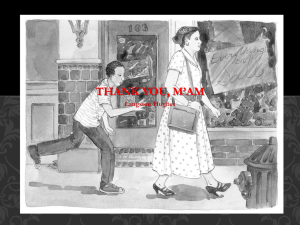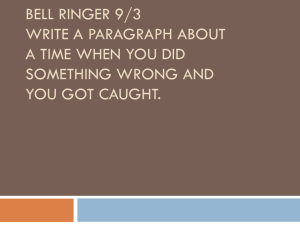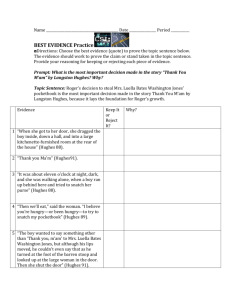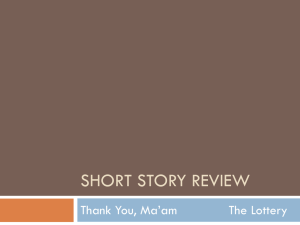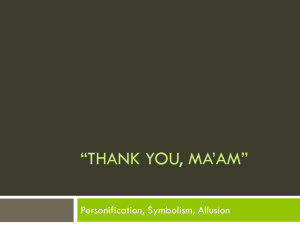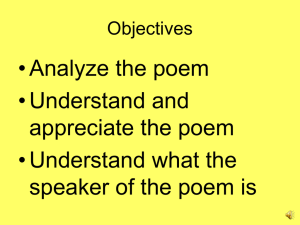Thank You Ma`am
advertisement
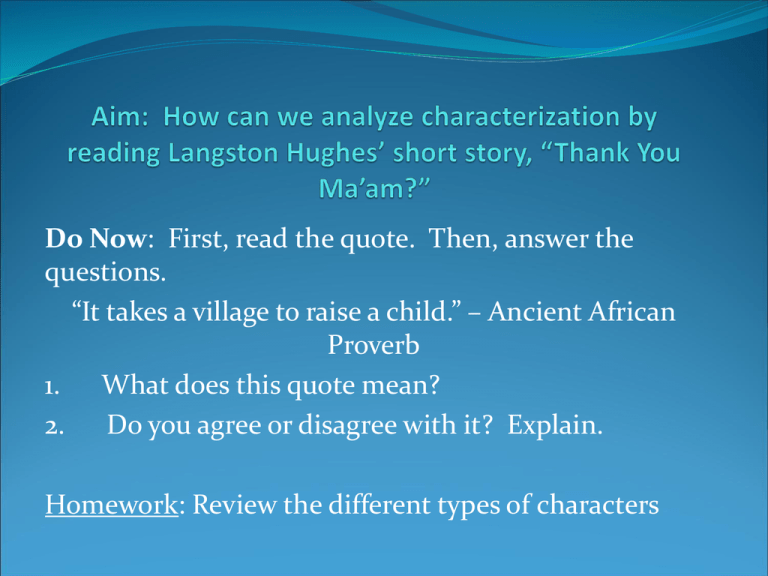
Do Now: First, read the quote. Then, answer the questions. “It takes a village to raise a child.” – Ancient African Proverb 1. What does this quote mean? 2. Do you agree or disagree with it? Explain. Homework: Review the different types of characters Aim: How can we analyze characterization by reading Langston Hughes’ short story, “Thank You Ma’am?” Characterization: How a writer depicts a character either directly or indirectly What type(s) of characters have you encountered within literature ? Aim: How can we analyze characterization by reading Langston Hughes’ short story, “Thank You Ma’am?” The protagonist is the central character (person, animal, or personified object) in the plot's conflict. Example: John Proctor from The Crucible The antagonist is the force in conflict with the protagonist. It may be society, nature, or fate, as well as another person. It can also be the protagonist's own self, if he or she has an internal conflict. Example: Abigail Williams from The Crucible A character foil is a character whose traits are in direct contrast to those of the principal character. The foil therefore highlights the traits of the protagonist. The foil is usually a minor character, although if there are two protagonists, they may be foils of each other. Reverend Hale (is in direct contrast to John Proctor) Elizabeth Proctor (is in direct contrast to Abigail Williams) Aim: How can we analyze characterization by reading Langston Hughes’ short story, “Thank You Ma’am?” A stereotype is a character who possesses expected traits of a group rather than being an individual. Using stereotypes is usually considered an indication of poor quality, especially in cases such as members of minority groups, people with disabilities, or women. However, stereotypes can be useful in furthering the story quickly and are acceptable in minor roles if they do not provide hurtful portraits of the groups in question. The teen sitcom, Saved By The Bell features a typical group of high school stereotypes such as a class clown (Zack Morris), a jock (A.C. Slater), a nerd (Samuel "Screech" Powers), a cheerleader (Kelly Kapowski), a feminist (Jessie Spano), and a superficial fashion plate (Lisa Turtle) Aim: How can we analyze characterization by reading Langston Hughes’ short story, “Thank You Ma’am?” A flat character (minor character) is not fully developed; we know only one side of the character. Elizabeth Proctor from The Crucible A round character (main character) is fullydeveloped, with many traits--bad and good-shown in the story. We feel that we know the character so well that he or she has become a real person. Giles Corey from The Crucible Aim: How can we analyze characterization by reading Langston Hughes’ short story, “Thank You Ma’am?” Start reading the short story “Thank You Ma’am” by Langston Hughes Who is the story really about? How does Roger react after Mrs. Jones asked him why he tried to steal her pocketbook? Why do you think Roger lied to Mrs. Jones? What does Mrs. Jones say when Roger apologizes? Are you surprised with Mrs. Jones' reaction? Why or why not? Aim: How can we analyze characterization by reading Langston Hughes’ short story, “Thank You Ma’am?” Why do you think Mrs. Jones makes Roger wash his face and then eat dinner with her? How does Mrs. Jones treat Roger? Why does Roger try to steal the purse? How does Mrs. Jones react to Roger's answer? How does Roger react to Mrs. Jones' saying that Roger could of just asked her for the money? What is Roger thinking about here (with the pause)? Aim: How can we analyze characterization by reading Langston Hughes’ short story, “Thank You Ma’am?” After Roger frowned, what did Mrs. Jones say? How did Mrs. Jones know what Roger was thinking? Have you ever noticed a look on someone's face and known what they were thinking? Give an example from your life Now what does Mrs. Jones tell Roger about her life? Aim: How can we analyze characterization by reading Langston Hughes’ short story, “Thank You Ma’am?” Why does Mrs. Jones not watch Roger or watch her purse? Where does Mrs. Jones work? In a beauty shop Do you think she is rich? Then why did she give Roger $10 to buy shoes? What do you think Roger learned from the way Mrs. Jones treated him? How would you like to be treated if you were caught doing something wrong? Aim: How can we analyze characterization by reading Langston Hughes’ short story, “Thank You Ma’am?” What advice did Mrs. Jones give Roger? What lesson about life does this story teach? Make a list of three important events or details that suggest the story's theme.
